 |
  |
 |
  |
The Katha of Mudras Asamyukta Hastamudras from the Natyashastra as seen in Kathak Parampara - Sunil Sunkara e-mail: sunilrsunkara@gmail.com February 10, 2020 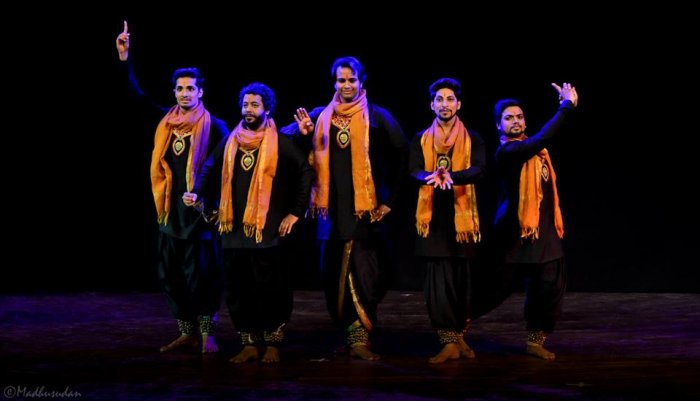 While in the Natyashastra Chapter IX on Upangabhinaya, Bharata refers to the gestural language as hastas, the word mudra is seen in the Bharatarnava, a later work by Nandikeshvara. It is also seen as a part of tantra culture, whose communities were closely following the commentaries of the Natyashastra. Thus, we come across the joint word hasta-mudra that later came to be referred to colloquially as 'mudra'. While looking at the history of Kathak, one can see its focus was towards drawing emotions from the daily life of people and creating connections with narratives from itihasa, which is what we perceive as a 'lokadharmi' approach. The kathavachaks or travelling bards were a medium of mass communication. The stories they weaved drew on lessons from itihasa like Mahabharata or Ramayana. Abhinavagupta and Bhatta Nayaka, 10th CE, speak of Saadharanikarana - art enabling the viewer to live the emotions, thus a tool for thought inception. The Communicator (the Kathak dancer) and The Subject (the audience) are bound through The Objective (the creation of the rasa). The use of mudras requires the subject audience to understand the meaning or signature behind usage of the mudras. This knowledge was to be found mostly among the elite post the 18th CE, making it a necessity for the kathiks to start using as 'close to life' depictions as possible. In the 20th CE, the reformation and revival in Kathak, especially with the advent of government supported institutions led to recreation of both the knowledgeable sahhridayi audience as well as an expansion in the 'vastukram' or repertoire of Kathak to bring to the fore once again a dance laced with the implied beauty of meanings through Kathak adorned by various mudras. This article looks at the various Asamyukta hastas mentioned in the Natyashastra, attempting also to connect with their current popular usage in Kathak. A valuable reference has been the in-depth analysis on mudras done by Dr. Vibha Dadheech, Bharatiya Nritya Ki Varnamala Hasta-Mudrayen. There are twenty-four gestures of single hands. Taking reference of Dr. M.M. Ghosh's translation of the Natyashastra (NS), the uses (viniyoga) of the gestures that have been given by Bharata and found in Kathak parampara have been given below along with other non-mentioned uses of the mudra wherever popular usage exists within the Kathak paradigm. 1. Pataka (Flag) - The fingers extended and close against one another, the thumb bent. 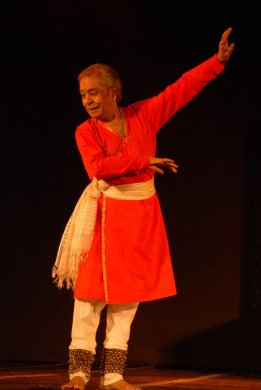 Pataka has a number of uses cited in the NS that are also used in Kathak. 1. To slap 2. To show scorching heat 3. To show attainment of happiness 4. To arrogantly refer to one's own self 5. To show torrential rain 6. To show a shower of flowers, two Pataka hands with the fingers separated and moving are to be joined together 7. To show a shallow pool of water 8. To make a present of flowers 9. The same Pataka hands with their fingers pointing downwards to be used to represent anything closed, made open, protected, covered, dense or private (to be concealed) 10. The Pataka hand with its fingers pointing downwards and moving up and down is to express the speedy movement of wind and ocean waves breaking against the shore 11. The rechaka of this hand to be used to represent encouragement, many (in number), a great crowd of men, height, beating of drums, flight of birds upwards 12. To show anything washed, pressed, cleansed, pounded should be represented by palms of hands running each other 13. To show holding up a hill or uprooting it 14. Of representing man and woman 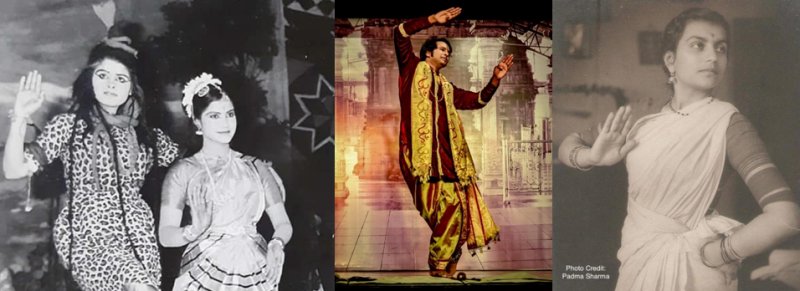 L: Neelam Awasthi as Shiva and Vibha Dadheech as Parvati C: Sunil Sunkara depicting dhwaja R: Padma Sharma showing ashirwaad The Pataka is one of the most often used mudras in Kathak and all the nritta hastas use them. A special focus in Kathak is on the delicacy as well as sharp, circular movement of the wrist. For this, it is necessary to often time relax the Pataka hand to a natural stance. 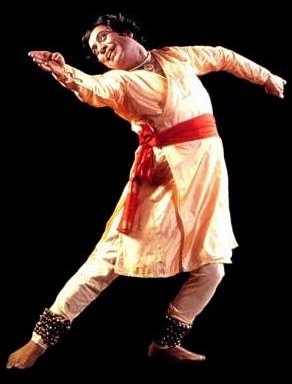 On the sam-Pt Birju Maharaj 2. Tripataka (Flag with three fingers) - the third finger of the Pataka hand to be bent 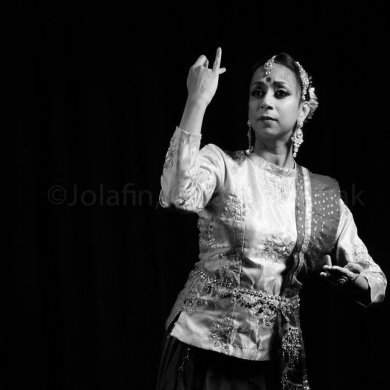 The following three uses given by Bharata are seen commonly in Kathak. 1. Drawing of tilak 2. Showing of lamp (jyoti) 3. Putting on a crown 3. Kartarimukha (Scissors blade) 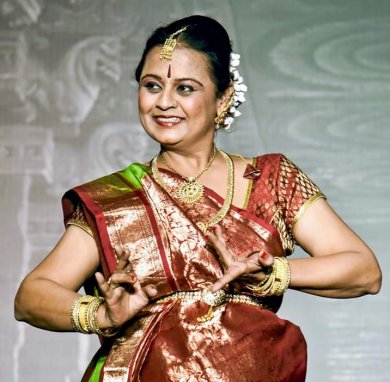 Bharata gives a use as to decorate or dye the feet, which is depicted sometimes in Kathak. Apart from the NS viniyogas, Kartarimukha is also used in Kathak to show creepers. Above, Paullumi Mukherjee depicting Kartarimukha (to show brilliance) in right and Alapallava in left (to show a luminous jewel). 4. Ardhachandra (crescent moon) - the fingers and thumb so bent as to make a curve like a bow. The following two uses given by Bharata are used in Kathak. 1. To show crescent moon 2. To show ornament 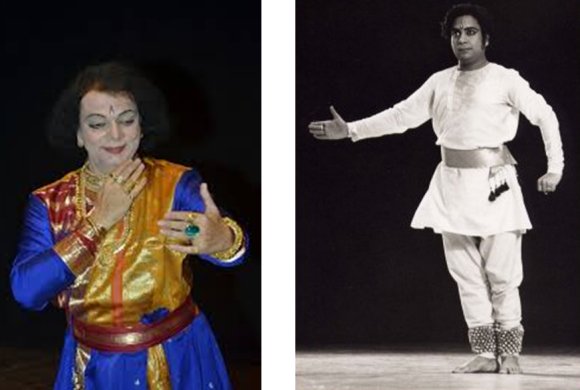 Left: Dr. Nandkishore Kapote uses the Ardhachandra to depict a mirror. Right: Pt Birju Maharaj using Ardhachandra and Mushti to depict the blocking of a path 5. Arala (bent) - The forefinger curved like a bow. Not used in Kathak traditionally. 6. Shukatunda (parrot beak) - the ring finger (third finger) of the Arala hand is bent. Not used in Kathak traditionally. 7. Mushti (fist) - fingers have their ends bent into the palm and the thumb is set upon them. The following three uses given by Bharata are used in Kathak. 1. To represent beating 2. While milking of cows 3. Grasping weapons 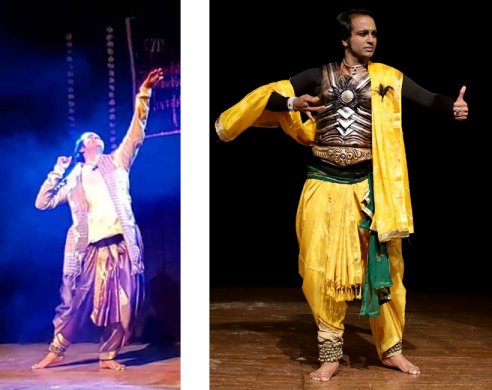 Left: Using Mushti to depict Gada and Pataka to depict the Sanjeevani mountain Right: Depicting bow using Shikhara in left hand and arrow using Katakamukh in right 8. Shikhara (peak) - in the mushti hand, the thumb is raised. From the NS the following two uses are seen in Kathak tradition today. 1. Depict a bow 2. Painting/delineation of lips Apart from this in Kathak, Shikhara is used to show a flask filled with water or wine, to depict power, to depict a conch and also as a stylus. 9. Kapittha (elephant-apple) - The forefinger of the Shikhara hand to be bent and pressed by the thumb. While the NS viniyogas such as depiction of weapons, thunderbolts etc are not used in Kathak, the Kapittha is used to show a bird, e.g. nayika talking to a koyaliya 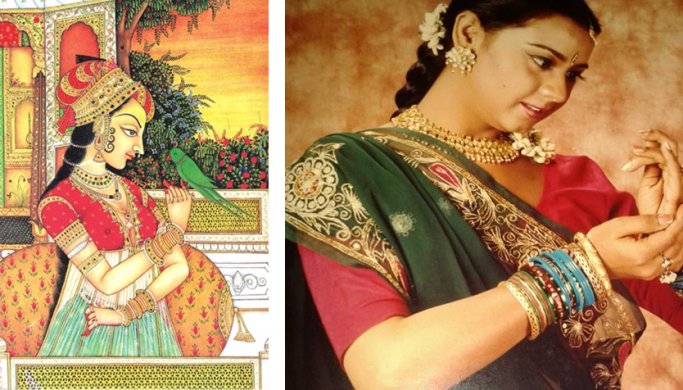 The parrot, a friend of the Nayika, an imagery used often in Thumri Bhaav of Lucknow Gharana Kathak (portrayed here by Paullumi Mukherjee) 10. Katakamukha- The ring finger and the little finger of the Kapittha hand to be raised and bent. 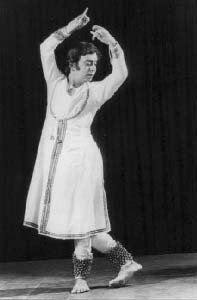 Viniyogas given in the NS that are used in Kathak. 1. Drawing reins 2. Holding a mirror 3. Holding a fan 4. Drawing a pattern 5. Arranging a pearl necklace 6. Wearing a garland 7. Gathering ends of a cloth 8. Churning 9. Drawing of an arrow 10. Plucking flowers 11. Wielding a long whip or holding a stick 12. Showing a rope 13. Representing a woman Later texts sometimes refer to this depiction as Kapittha, in divergence from Bharata. 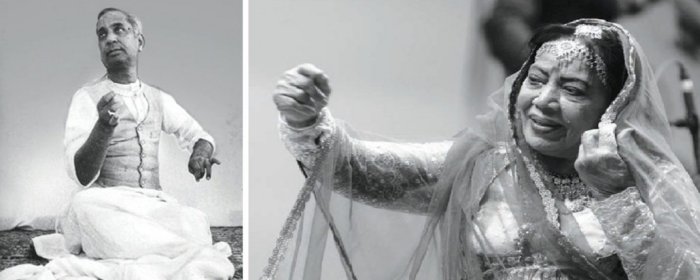 Left: Shambhu Maharaj depicting an aanchal using Katakamukh Right: Sitara Devi holding ghunghat using Kapittha 11. Suchimukha- the forefinger of Katakamukha hand is stretched. 1. To represent the discus 2. To show lightning 3. To show earrings 4. To depict a zigzag movement by the shaking and moving up-down of the forefinger 5. To show the number one 6. A circular movement of the forefinger to represent taking away 7. To indicate no, or to speak, the forefinger should be stretched, shaken or moved up. 8. Used to represent anger, perspiration, hair, earring, armlet and decoration 9. To represent pride, 'I am'; enemy; 'Who is this man?' 10. In scratching of the forehead while thinking 11. Two Suchimukha hands united to represent union, separated to show separation, crossed to quarrel 12. Using two Suchimukha hands, the orb of the full moon to be represented 13. Held at the forehead to represent Shiva's third eye 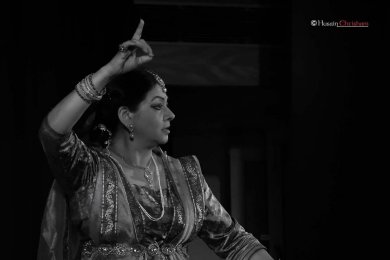 Renu Sharma using Suchimukha to depict Vishnu's discus 12. Padmakosha (Lotus Bud) - The fingers including the thumb to be separated and their ends to bend, but not to meet one another. 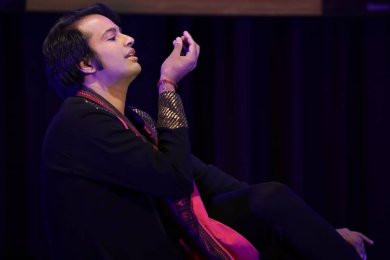 Nayak inhaling fragrance of a flower 1. To represent bilva and other fruits/berries 2. To represent the breasts of women 3. To show flowers/buds 4. Offering puja to a deity 5. To depict the bloomed lotus/water lily 13. Sarpashirah (snake-head) - the fingers including the thumb to be close to one another and the palm to be hollowed. 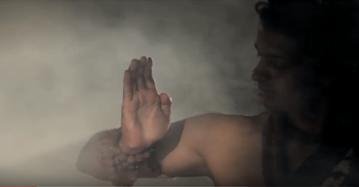 1. Offering of water 2. Movement of serpents 3. Motion of the elephant's frontal globes Serpents are shown in Kathak using single as well as both hands. 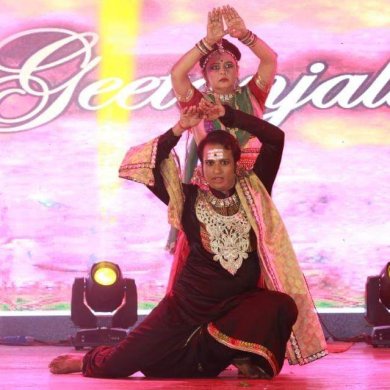 14. Mrigasheersha (deer-head) - The Sarpashirah hand with all its fingers pointing downwards, but the thumb and little finger raised up. 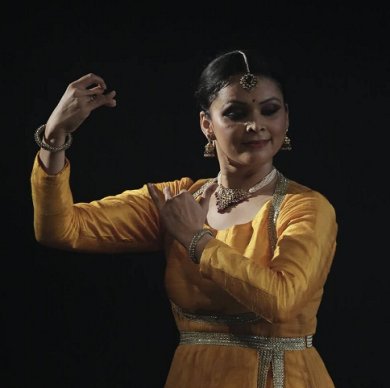 Gauri Diwakar The NS viniyogas are not seen in Kathak tradition, but we do see Mrigasheersha used in Kathak sometimes to depict a deer or a flute, e.g. depicted above by Gauri Diwakar where she shows a combined Radha Krishna showing flute using Mrigasheersha and ghunghat using Katakamukha. 15. Kaangula - The middle and forefingers and the thumb to be separated and the ring finger to be bent, but the little finger raised. The NS gives its usage to represent small fruits, sometimes used to depict berries. Kaangula is also used at times in Kathak tradition to depict 'Kaushtubhmani' worn by Lord Krishna, for example in the line 'Vakshastale Kausthubam.' 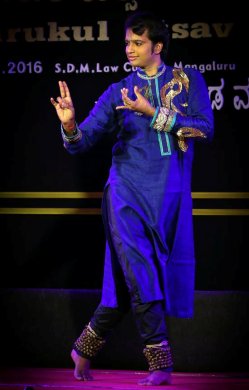 16. Alapallava (Alapadmaka) - All fingers turned towards the palm, standing on its side and separated from one another. 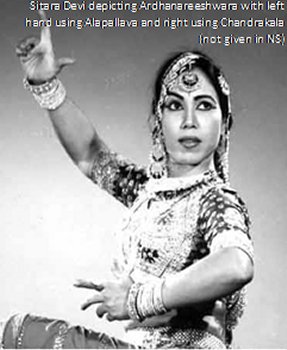 As per the NS indicating phrases like 'of whom are you', 'nonsense,' Alapallava may be used. One will find this being used in Kathak abhinaya in the passing. 17. Chatura - The four fingers stretched and the thumb bent near middle finger. As per the NS, it is used to depict petals of the lotus on which divine beings sit. This is used in depiction of various deities like Brahma, Saraswati, Lakshmi who are seated on the bloomed lotus. 18. Bhramara (bee) - The middle finger and the thumb crossing each other, the forefinger bent and the remaining two fingers separated and raised. The NS viniyogas used in Kathak is to show earrings (kundalas). The depiction of the bee is also done often using either the Bhramara or the Sandamsha in Kathak style. 19. Hamsasya (Swan-Beak) - The forefinger, middle finger and the thumb close to one another and the remaining fingers stretched. There is great discrepancy in later texts over the delineation of this mudra. The NS description of Hamsasya is taken in later texts to be the Katakamukha. The NS viniyoga of depicting of fine, small and loose things is seen in Kathak. It is also commonly used to depict the flute. 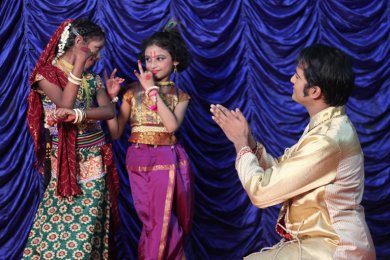 Radha using Kapittha, Krishna using Katakamukha and Bhakta in Anjali 20. Hamsapaksha (swan-wings) - The three fingers stretched, the little fingers raised and the thumb bent. Bharata gives its use to apply unguents, which is seen in Kathak in instances such as application of mehendi to the hands. 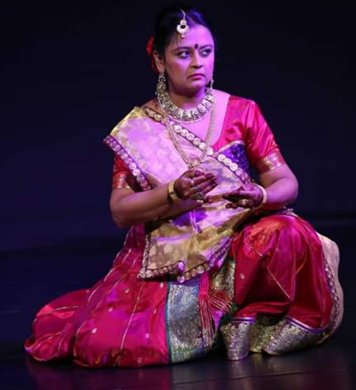 Paullumi Mukherjee using Hamsapaksha to depict mehendi 21. Sandamsha (pincers) - The forefinger and the thumb of the Arala hand crossed and the palm a little hollowed. This description is unique to the Natyashastra as in later texts the Sandamsha is depicted as claws and not as pincers. Importantly, this is the closest depiction of the most commonly seen mudra in Kathak apart from Pataka, that is often termed as 'chin mudra' borrowing from yoga mudras or a variation of the later texts version of Hamsasya. The most iconic pose of Kathak, that is the style's signature hallmark, the 'sudhang' or 'nikas' uses the Sandamsha as depicted by Pt Birju Maharaj. 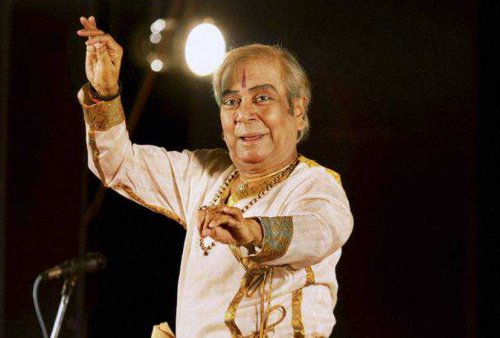 Pt. Birju Maharaj The NS gives a number of viniyogas for the Sandamsha which are commonly depicted in Kathak. 1. Plucking of flowers 2. Taking up grass, leaves, hairs or threads 3. Pulling out an arrow or thorn 4. Taking off a flower from its stem 5. The wick of a lamp 6. Collyrium stick 7. Piercing a hole in pearls and similar objects 8. To show the bow-string 9. To depict fineness 10. In connection with Yoga and meditation 11. To indicate painting 12. Colouring one's eyes 13. To show a stem 14. To depict writing 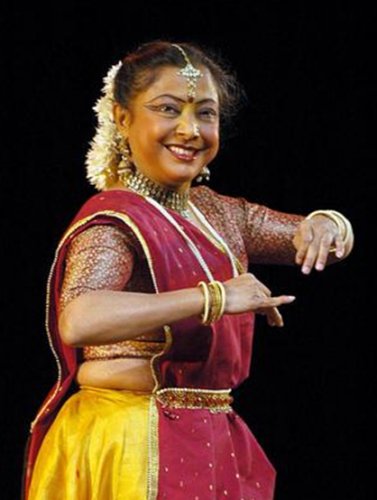 Saswati Sen 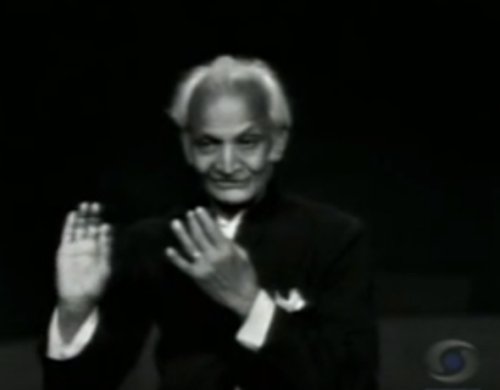 Pt Lacchu Maharaj depicting flute - use of Sandamsha mudra 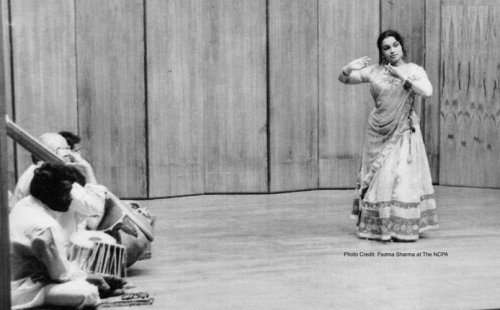 Padma Sharma depicting flute - use of Sandamsha mudra 22. Mukula (bud) - the fingers bent and close to one another and their tips meeting together in the Hamsasya hand or when all the fingers are joined in the Padmakosha hand. 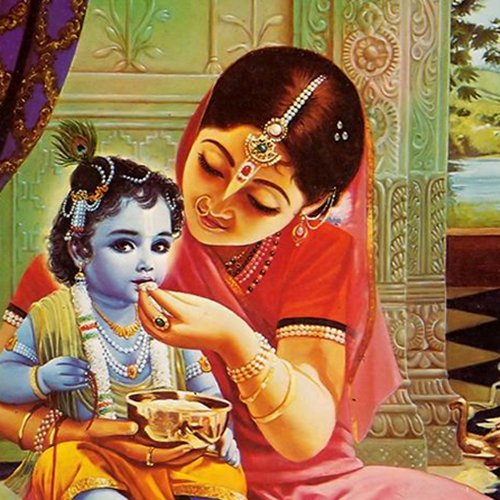 Makhan Chori - Stealing of butter, where eating, feeding of butter is done using mukula. The following uses cited in the NS are seen in Kathak. 1. Bud of a lotus or waterlily 2. Throwing a kiss (vita-chumbana) 3. To show contempt 4. Taking meals 5. Giving away anything 6. Making offerings in the worship of a deity 23. Urnabha (Spider) - The fingers of the Padmakosha hand further bent. Again unique to the NS, this hasta is not seen in later texts. The following viniyogas from the NS are used in Kathak. 1. Holding one by hair 2. Scratching one's head 3. Lions, tigers and such animals, to depict claws Popularly, it is used in the depiction of the Narasimha avatar of Vishnu in Dashavatar in Kathak. 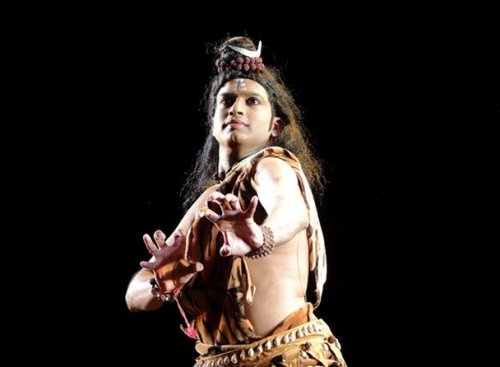 Use of Urnabha while depicting Shiva wearing tiger hide 24. Tamrachuda (copper-crest/cock) - the middle finger and the thumb crossed, the forefinger bent, the remaining two fingers at the palm. NS gives one of the uses as 'the hand is moved freely to represent sparks or drops'. This is used sometimes in Kathak. 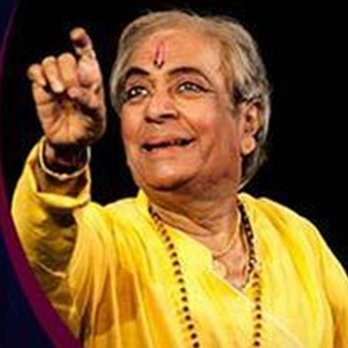 Most commonly it is used in Kathak to depict a generic bird. It is also used to depict Yamadeva through indication of his 'noose' of death. Yamadeva is shown using Tamrachuda held obliquely as shown below where Yama leads on the spirits to the afterlife. 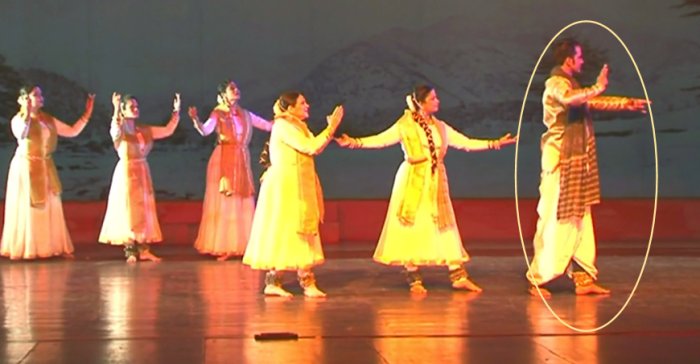 Thus other than Shukatunda and Arala we see the rest of the single handed gestures described in Natyashastra being used today in Kathak, though not always in the uses as prescribed by Bharata. But Bharata does give freedom for the parampara to develop and this is reflected in the Kathak parampara. References 1.Natyashastra of Bharatmuni, Text, Commentary of Abhinava Bharati by Abhinavaguptacharya and English Translation, Vol I - English Translation by MM Ghosh, Edited by Prof. Pushpendra Kumar, New Bhartiya Book Corporation, 2006 2. Bharatiya Nritya Ki Varnamala Hasta - Mudrayen, Dr. Vibha Dadheech, Bindu Prakashan, 2003 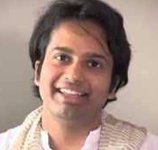 A chemical engineer who has pursued his doctorate in biofuel research, Sunil Sunkara holds a masters degree in Kathak from Bharata College of Fine Arts and Culture, Mumbai, and Nritya Nipun from Bhatkhande Sangit Vidyapith, Lucknow. He performs regularly as well as pursues research in Kathak apart from curating dance events and regularly writing on various facets of dance through both print and online medium. Post your comments Pl provide your name and email id along with your comment. All appropriate comments posted with name and email id in the blog will also be featured in the site. |